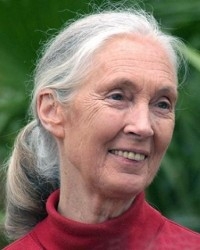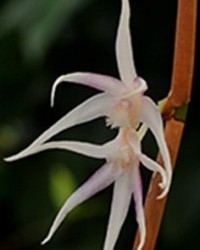
Meet and greet Jane Goodall in Leiden’s Hortus
Primate and test specialist Jane Goodall paid a visit to the Hortus botanicus in Leiden on 21 May for a ‘meet & greet’. Goodall, a world-famous researcher and nature protectionist, was presented with an orchid named after her and used the occasion to draw attention to the issue of plant protection. 'We need to test & think about what woodlands and forests do for us.'

Her own orchid
‘Plants can disappear rapidly and maybe for ever,’ Rogier van Vugt, greenhouse manager, began his introduction. ‘Jane knows it’s possible to overcome this. She brings hope.’ He then presented Goodall with the orchid Dendrobium goodallianum that has recently been named after her. Scientists at the Naturalis Biodiversity Center and the Hortus Botanicus discovered the plant in 2013 in Papua New Guinea. Goodall expressed her thanks for this honour. ‘One other plant has been named after me, a rose, but that is a cultivated plant. This orchid is wild, which makes it even more special.’
Seeds of hope

Goodall, who is now 81 years old, started her career as a primate researcher. She currently devotes all her time and energy to nature protection. She writes books and spends some 300 days a year travelling the world, giving lectures and meeting people. In the Hortus she talked about her latest book ‘Seeds of Hope: Wisdom and Wonder from the World of Plants’. Goodall, who a few minutes into her talk asked for a crate to stand on so she could see the back row of the fifty or so people who wanted to buy a ticket, wrote the book with help from Van Vugt. She stresses in the book the importance of plants and trees: ‘We have to think about what woods and forests do for us.’
Nature heals traumas
‘Plants keep the earth healthy by extracting carbon dioxide from the air and converting it to oxygen,’ she continued. ‘Nature also has a healing effect psychologically. There are many accounts of people who lost the power of speech as a result of a war trauma, and who only managed to find their voice again in nature. It is such a pity that young people today are so remote from nature, but that is something we can change. Botanical gardens can play a huge role here.’
Jane Goodall Institute
The Hortus botanicus organised the meet & greet together with the Jane Goodall Institute that was set up in 1998. The institute has 27 branches worldwide. Its mission is to protect nature, including preserving the natural environment for apes in Africa. The proceeds from the visit to the Hortus (the lunch, books and other items) were donated to the institute.
Pioneering research
Jane Goodall started her research on chimpanzees in 1960, at the age of 26, in Gombe, Tanzania. She lived with these animals for many years. The British government was initially strongly opposed to the idea of a young woman alone going to live with wild animals in Africa, but withdrew their objections when Goodall’s mother Vanne decided to go with her. One of Goodall’s most amazing discoveries was that chimpanzees make and use tools. They use sticks, for example, to poke into termite nests to catch the termites.
